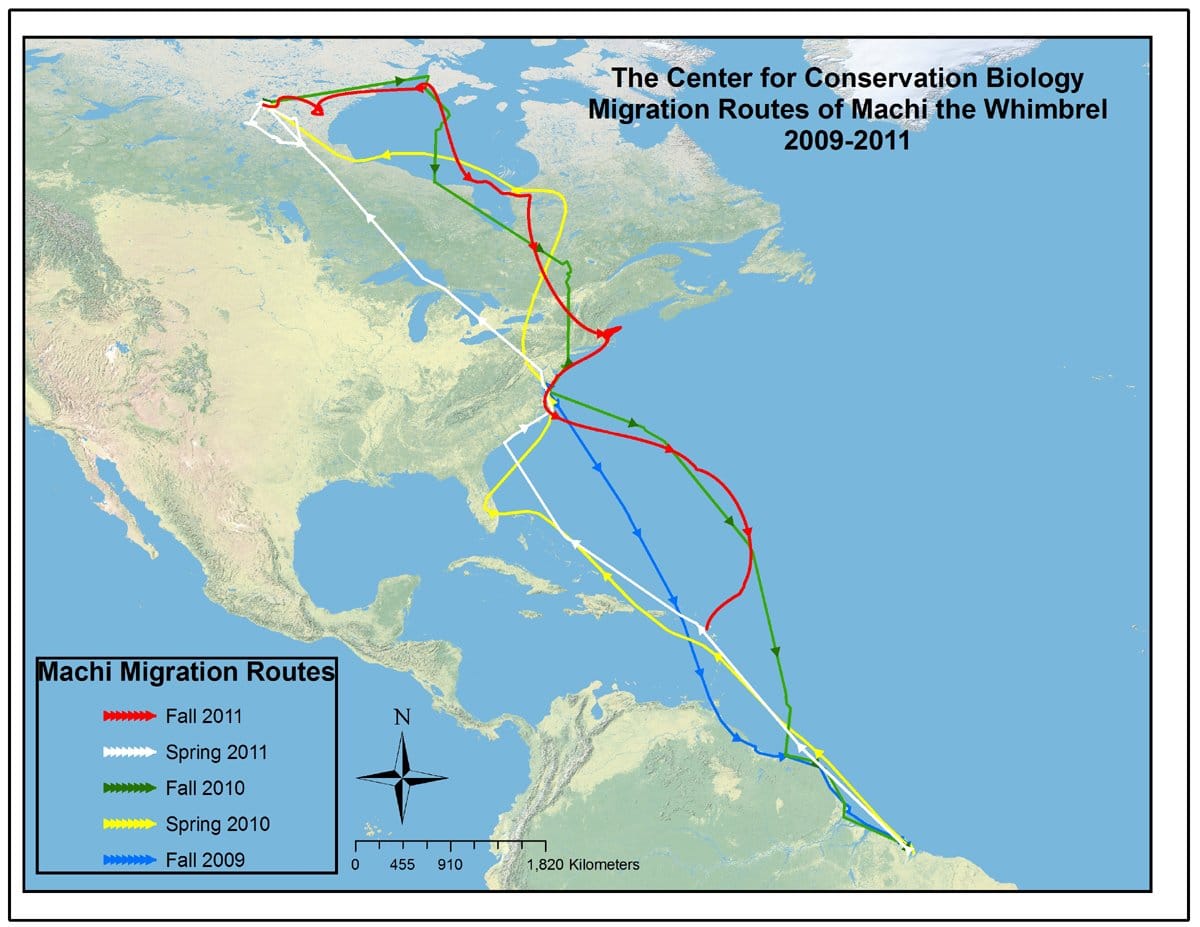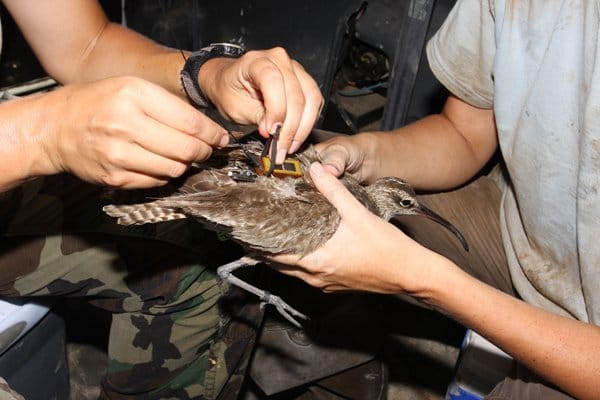Scientists at The Center for Conservation Biology have announced that Machi, a Whimbrel that they have tracked via a satellite transmitter for over two years and 44,000 kilometers (27,000 miles) was gunned down on the Caribbean island of Guadeloupe (French West Indies). This is a bird that flew over 3,400 miles in one flight from Brazil to South Carolina, an amazing bird that is representative of every other Whimbrel. And though the satellite transmitter let Machi be tracked it did not protect it from the hunters’ guns. Look at the amazing journeys that this bird had made and then say that it wasn’t a disgusting act to shoot such an astounding and amazing creature.
Machi’s Migration Map courtesy of The Center for Conservation Biology
What is even more shocking is that it was perfectly legal to shoot Machi. Why?
Guadeloupe, Martinique and Barbados continue to operate “shooting swamps” some of which are artificial wetlands created to attract migrant shorebirds for sport shooting during fall migration. It is estimated that tens of thousands of shorebirds continue to be taken annually by hunting clubs on just these three islands. This practice is a throwback to more than a century ago when gunners hunted shorebirds throughout the Americas. The Migratory Bird Treaty Act was passed, in part, to protect dwindling numbers of birds that migrate across country borders. Operated as a French overseas department, both Guadeloupe and Martinique are part of the European Union and are not party to the Treaty. Barbados, once a British colony is now an independent state and also not party to the Treaty. The last Eskimo Curlew known to science was shot on Barbados in 1963. Shorebird hunting within these areas continues to be unregulated to the present time. Conservation organizations continue to work toward some compromise that will reduce pressures on declining species.
Machi was, of course, only one bird. But the toll the “shooting swamps” take on the shorebirds of the Americas is huge and the practice must be stopped. Suggestions to start a campaign to protect shorebirds from hunters as they migrate through the Caribbean would be appreciated in the comments. Let’s make Machi’s death mean something!
Machi getting fitted with transmitter in 2009. Image courtesy of Barton Paxton.
Hat-tip to Donna Schulman for the information about Machi.
…













Whimbrels are my favorite bird ! I first encountered them in Bristol Bay, Alaska, on the tundra near our fish camp. Lately, I see them in Crescent City, Calif., where it seems they are there whenever we visit…Let me know if there are serious efforts to stop the killers.
This is the kind of story that will capture the attention, imagination and concern of the general public. The Center for Conservation Biology
should make a serious effort to get this onto radio, TV and all over the web. Worded properly, the saga of this little soldier is just as heart-wrenching as any human interest story.
French hunters are an extremly powerfull lobby in France, and they pretty much decide themselves what they can hunt and when. Many protected bird species (including ortolan bunting, for instance) are illegally poached, with the DNR (or french equivalent) turning a blind eye to it.
The french hunters are possibly the best birders in the world, because they are allowed to hunt ducks at night, which means they are able to make a split second ID in the dark before they decide whether the duck is on the protected species list or not.
Don’t think I am being anti-french here, because I was born and raised there.
This week I wrote an article for Suriname and Dutch media on the whimbrel Chinquapin, which now is on the Bahamas on its way to the shores of Suriname (where – Paramaribo, Suriname – I, Dutch, live and work as freelance journalist). Chinquapin survived Irene this year and Colin in 2010. Amazing what such a small bird can accomplish. I do hope Chinquapin will not be shot by illegal Suriname hunters. Hunters are here very active in coastal areas. The article I wrote on Chinquapin can be found on my blog http://freelance-in-suriname.blogspot.com, in Dutch that is, sorry.
This makes me so angry. I didn’t even know this this problem existed but hopefully this story will help in putting a stop to the hunting of shorebirds on those islands.
whoever did this will die the same horrible deah which he/she deserves hunters are cowards
what a sad story… and here I mistakenly thought loss of habitat was the biggest danger to migrating birds. The map showing this individual bird’
s migration route is amazing, but no match for a gun.
Hunters should be encouraged to try birding with binoculars instead or even bird photography. A good hunter will make an excellent bird in flight photographer. It’s a pity the bird flew such a great distance just to end up on a plate!
Do they they end up being eaten? I thought they were just “trophies” for sad people who find “fun” in killing.
While I personally hope that hutning shorebirds on these islands is outlawed, some of you are speculating about who killed Machi and why that was done. That’s irresponsible at best. None of us are perfect, and it’s possible it was a shamelss, purposeless act. However, for all we know, the shooter has family who is alive now because of Machi’s sacrifice. As a lifelong birder and relatively recent hunter, I can tell you that most hunters in the US are very concerned about conservation. The hunters I know have more respect and admiration for the animals they harvest than just about any other group. I would guess (and it is a guess) that groups like Ducks Unlimited and Delta Waterfowl do more to propagate wildlife and keep ecology and habitat in balance than any other group. In fact, just this year several species of waterfowl had population numbers that are the highest since surveys began in the 1950s, and almost every waterfowl species in N America had consistent numbers. Why? Because of the millions and millions of dollars hunters spent on lobbying efforts and land preservation (purchasing and setting aside purely for safe nesting habitat). This is the proof that not all hunters are cowards and that they literally put their money where their mouths are. Sharon, people like you don’t serve your purpose very effectively. Stop with the ignorance, fear and hate and start trying to genuinely and carefully educate people and provide for their physical needs and you’ll probably save Machi’s offspring.
On a different note, thanks to the folks who have provided this website. I appreciate the ability to share ideas and learn more. Good stuff.
Now Machi has been joined by Goshen, who didn’t even get a chance to land before being blown away.
Shorebird hunting has gone on in Guadaloupe and Barbados for generations. They have “hunting swamps” where the birds congregate, and so do the hunters, 3000 every year by one report.
I was saddened and angered by these reports, but like so many environmental issues, you get your blood to boiling, and all that happens is nothing, so you let it go. I then stumbled onto this video on You-Tube shot in Guadaloupe :
http://www.youtube.com/watch?v=bWFC2fEqVfI
Watch it if you dare. It’s pretty graphic. It’s one guy with one gun and two dogs and a camera mounted near his gun. Two of the birds he shot were Whimbrels, you could tell as he pulled them to shore. The others were all about the right size. I stopped counting at fifteen kills. There were more.
These are our birds they are playing with down there. No laws, no control, no nothing. And this seems to be sport shooting, not subsistence. With pressure like this it’s not hard to understand what happened to the Eskimo Curlew. Will Whimbrel be next. Their east coast numbers are already down to 50% of 1990 figures. And don’t forget the rufa Red Knot. It is staring extinction in the face. What in heaven’s name can we do?
Mitch, there are, indeed, responsible, conservation-minded hunters. I am friends with several, and I comment regularly at a few hunting blogs where such hunters reside — even though I’m very strongly in the non-hunting camp. It was (sadly) my experience in the field as a wildlife rehabilitator and photographer — sharing land with hunters — that turned me from accepting hunting to being disdainful of it. Watching sky busters in action on the wetlands will turn you pretty quickly.
With waterfowl hunting and wing shooting, especially, the wound rate is extremely high. Studies documenting the crippling rate of ducks and geese are woefully inadequate, but one of the few studies done estimated a rate as high as 25 percent. Which means millions of ducks and geese injured by hunters each year, crippled, and never retrieved. These are difficult numbers to reconcile, made more difficult when you come upon one of these crippled animals and understand the repercussions firsthand.
As far as Delta Waterfowl and Ducks Unlimited, there is no question about their value in habitat restoration. At the same time, there are no programs in place (comparable to hunting fees) which levy fees on non-consumptive uses of public land — like birdwatching, photographing and other activities. We could generate much more funding for restoration efforts, given how much we non-consumptive wildlife watchers outnumber hunters. Mike here at 10000 Birds once wrote a great blog post a couple of years ago about his ambivalence over duck stamps and how birders and the hunting lobby don’t necessarily share the same conservation goals. I share those sentiments.
“how birders and the hunting lobby don’t necessarily share the same conservation goals” – That they have different goals is unsurprising. But that doesn’t mean they can’t work together to protect and save important wild spaces.
Duncan, I agree completely. We all share a common interest in habitat preservation. It’s just that non-hunters don’t necessarily have the same representation when it comes to where the funds are allocated, toward what species and to what ends. This is where I’d like to see the funding structure changed to be more equitable.
Guadeloupe’s economy benefits from 400,000 tourists ever year, many of whom may prefer to choose an island where hunting is done responsibly if they were made aware of it. I vacationed on Martinique not knowing that they also have unregulated shooting swamps. Wish I’d spent my money elsewhere.
Most hunters participate in the sport because they enjoy spending time in the outdoors. It’s not just the killing or eating they are interested in. I suggest birders take a hunter they know out for a day of birding and maybe they will get hooked onto birding!
Two years ago in may, I witnessed a wonderful site, 30+ whimbrel ascending from Kirk Santon moss en-route to the north of Scotand. It was about 7 am, I was on my daily run and the weather was warm and sunny. It was a moment in time I shall never forget!